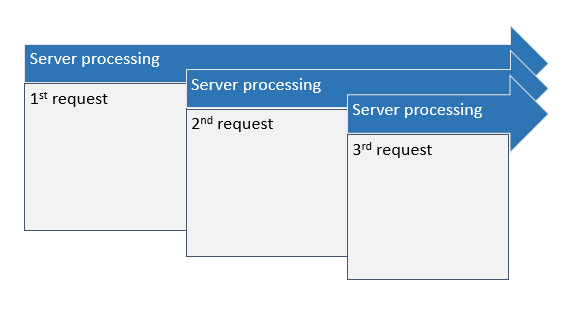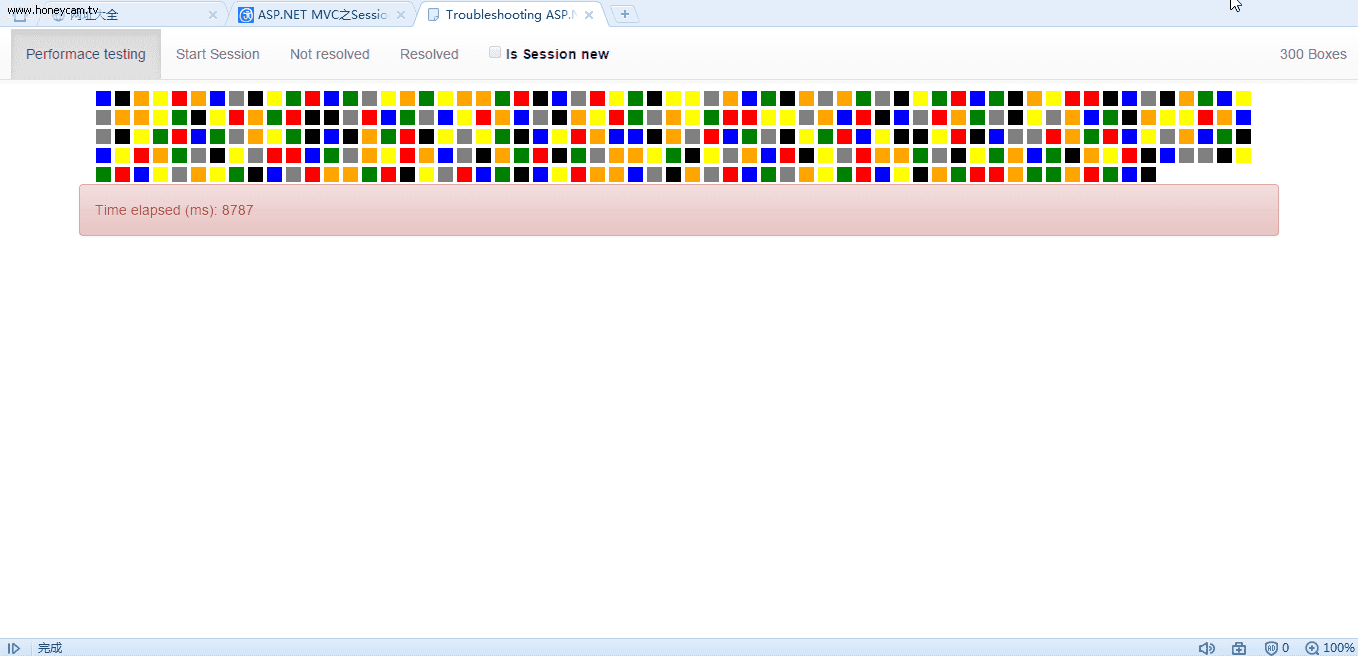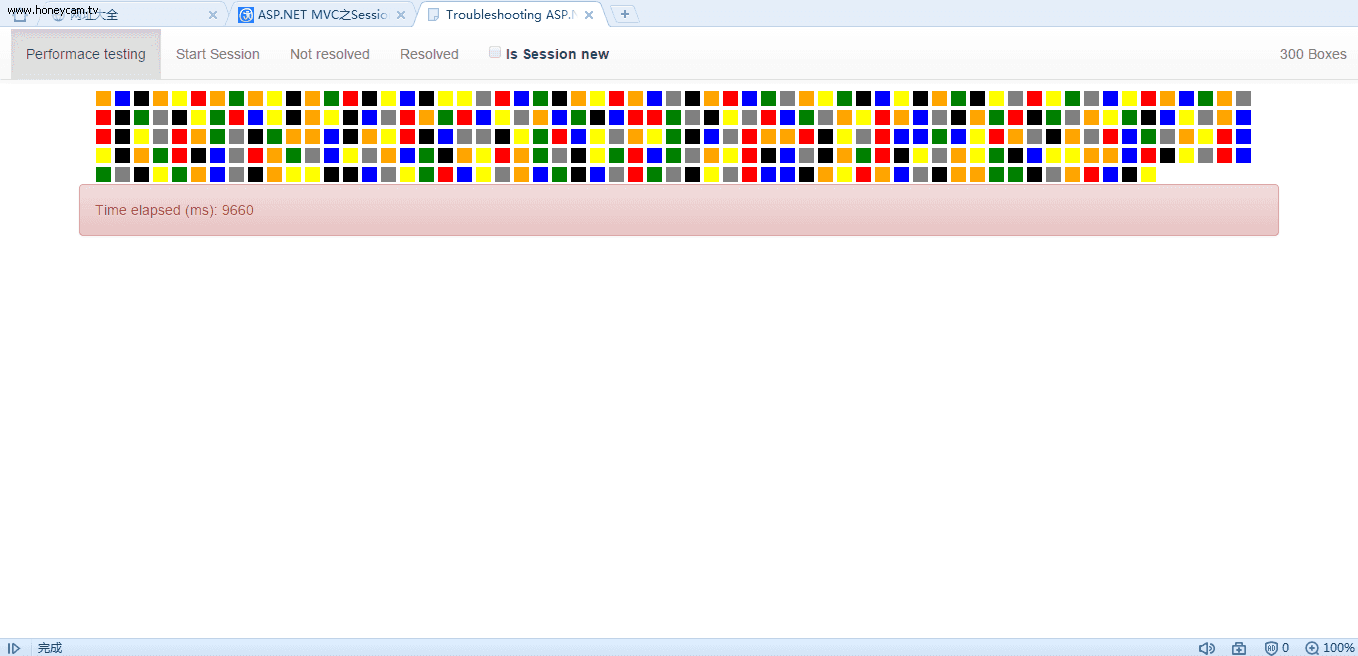ASP.NET MVC之Session State性能问题(七)
前言
这一节翻译一篇有关Session State性能问题的文章,非一字一句翻译。
话题
不知道我们在真实环境中是否用到了Session State特性,它主要用来当在同一浏览器发出多个请求时来存储数据,在现在我们更多的为了避免整个页面刷新,Web应用程序更多倾向于利用高扩展性的Ajax,但是不知道我们是否注意到当我们使用Session数据多次请求MVC上的Action方法时产生的性能问题呢?
将Session放入上下文中(Put Session into the Context)
在进行代码演示时我们首先得知道Session的工作原理:当一个新请求第一次到达服务器时,显然在此之前Cookie中没有SessionId的,此时服务器将创建一个新的Session标识,通过如下:
System.Web.HttpContext.Current.Session.SessionID
但是并不意味着当有多个请求发送到服务器上时,服务器都会保存一个Session Cookie。只是在Session中保存具体请求的数据,换言之,ASP.NET Framework会首先会添加Session Cookie到响应流中,此时需要保存的数据将被保存在Session中。
因此,说到这里好像和我们要讲的主题半毛钱关系都没有,那跟我们的性能有什么关系呢?ASP.NET能够处理来自同一浏览器的多个请求,如下:

在上述图片中,当浏览器未发出请求时显然在服务器上不会存储任何Session数据,如果服务器存储了一些数据在Session中,此时将会添加一个Session Cookie到响应流中,接下来所有的子请求使用相同的Session Cookie,同时会以队列的形式依次等待被处理。

我们能够想象到一种很常见的场景,要是多个请求同时去读取或修改相同的Session值,此时则会造成不一致的数据。接下来进入我们话题演示时间。
代码演示
我们在控制器中给出如下代码:
[OutputCache(NoStore = true, Duration = 0)] //不缓存数据 public class HomeController : Controller { public List<string> boxes = new List<string>() { "red", "green", "blue", "black", "gray", "yellow", "orange" }; // GET: Home public ActionResult Index() { return View(); } public string GetBox() //随机获取集合中颜色 { System.Threading.Thread.Sleep(10); Random rnd = new Random(); int index = rnd.Next(0, boxes.Count); return boxes[index]; } public ActionResult StartSession() //启动Session并存值 { System.Web.HttpContext.Current.Session["Name"] = "Chris"; return RedirectToAction("Index"); } }
接下来我们利用AngularJS在视图中发出Ajax请求以及其他操作,我们看看视图中代码:
<body ng-controller="asyncCtrl" ng-init="getBoxes()"> <nav role="navigation" class="navbar navbar-default navbar-fixed-top"> <div class="container-fluid"> <!-- Brand and toggle get grouped for better mobile display --> <div class="navbar-header"> <button type="button" data-target="#navbarCollapse" data-toggle="collapse" class="navbar-toggle"> <span class="sr-only">Toggle navigation</span> <span class="icon-bar"></span> <span class="icon-bar"></span> <span class="icon-bar"></span> </button> </div> <!-- Collection of nav links and other content for toggling --> <div id="navbarCollapse" class="collapse navbar-collapse"> <ul class="nav navbar-nav"> <li class="active"><a href="#">Performace testing</a></li> <li> @Html.ActionLink("Start Session", "StartSession") </li> <li> <a class="links" ng-click="getBoxes()">Not resolved</a> </li> <li> <a class="links" ng-click="getBoxes(true)">Resolved</a> </li> <li> <form class="navbar-form"> <label class="checkbox" style="margin-top:5px"> @Html.CheckBox("isSessionNewChk", Session.IsNewSession, new { @disabled = "disabled" }) Is Session new </label> </form> </li> </ul> <ul class="nav navbar-nav navbar-right"> <li><a href="#">{{boxes.length}} Boxes</a></li> </ul> </div> </div> </nav> <br /><br /><br /> <div class="container"> <div class="row"> <div id="boxesContainer" ng-repeat="color in boxes track by $index"> <div class="box" ng-class="color" /> </div> </div> <br /> <div class="row"> <div id="timeOccured" ng-show="showResults" class="alert" ng-class="isResolved()" ng-bind="timeElapsed"></div> </div> </div> <script src="~/Scripts/app.js"></script> </body>
接下来我们看看 app.js
angular.module('asyncApp', [])
.value('mvcuri', 'http://localhost:49588/home/getbox')
.value('mvcurisessionresolved', 'http://localhost:49588/SessionResolved/getbox')
.controller('asyncCtrl', function ($http, $scope, mvcuri, mvcurisessionresolved) {
$scope.boxes = [];
$scope.showResults = false;
var uri;
$scope.getBoxes = function (resolved) {
var start = new Date();
var counter = 300;
if (resolved)
uri = mvcurisessionresolved;
else
uri = mvcuri;
// Init variables
$scope.boxes = [];
$scope.showResults = false;
$scope.timeElapsed = '';
for (var i = 0; i < 300; i++) {
$http.get(uri)
.success(function (data, status, headers, config) {
$scope.boxes.push(data);
counter--;
if (counter == 0) {
var time = new Date().getTime() - start.getTime();
$scope.timeElapsed = 'Time elapsed (ms): ' + time;
$scope.showResults = true;
}
})
.error(function (error) {
$scope.timeElapsed = error.Message;
}).finally(function () {
});
}
};
$scope.isResolved = function () {
return uri == mvcuri ? 'alert-danger' : 'alert-success';
}
});
上述AngularJS脚本比较简单就不叙述。接下来再创建一个控制器 SessionResolvedController 来进行比较。
[OutputCache(NoStore = true, Duration = 0)] public class SessionResolvedController : Controller { public List<string> boxes = new List<string>() { "red", "green", "blue", "black", "gray", "yellow", "orange" }; public string GetBox() { try { System.Threading.Thread.Sleep(10); Random rnd = new Random(); int index = rnd.Next(0, boxes.Count); return boxes[index]; } catch(Exception ex) { return "red"; } } }
此时我们看看运行效果:

当我们运行程序时,此时复选框是勾上的,说明此时还未有添加数据到Session中,接下来我们点击 Start Session 看看效果:

上述我们是启动Start Session并控制整发出300个Ajax请求并返回随机颜色。我们看到花了8722毫秒。
接下来我们点击 Not resolved 看看耗时多少,如下:

耗时8166毫秒,看来和启动Session没什么区别可言。因为每个到服务器的请求都有一个Session Cookie,此时所有的请求将会被依次处理正如我们之前所描述的那样,所以接下来我们进行如下操作:
[SessionState(SessionStateBehavior.Disabled)] public class SessionResolvedController : Controller {.....}
我们禁用SessionState看看效果:

注意:上述程序运行建议在Release模式下进行演示,可能这样的效果更加明显。
参考
ASP.NET MVC Session state Performance Issue
结语
当有多个请求发送到服务器时此时若进行Session操作将会对性能产生一定影响。我们通过设置 [SessionState(SessionStateBehavior.Disabled)] 特性最终验证了这一观点。但是这样设置后我们将无法获取Session中的值。所以在请求数量较多的情况下,建议对于Ajax请求使用Web APi来完成,我们通过Web APi来接收Ajax请求,可以使用Session中的数据来渲染视图或者提交到数据或者参数到MVC控制器的Action方法上。

为了方便大家在移动端也能看到我分享的博文,现已注册个人公众号,扫描上方左边二维码即可,欢迎大家关注,有时间会及时分享相关技术博文。
感谢花时间阅读此篇文章,如果您觉得这篇文章你学到了东西也是为了犒劳下博主的码字不易不妨打赏一下吧,让楼主能喝上一杯咖啡,在此谢过了!
如果您觉得阅读本文对您有帮助,请点一下“推荐”按钮,您的“推荐”将是我最大的写作动力!
本文版权归作者和博客园共有,来源网址:http://www.cnblogs.com/CreateMyself)/欢迎各位转载,但是未经作者本人同意,转载文章之后必须在文章页面明显位置给出作者和原文连接,否则保留追究法律责任的权利。







【推荐】国内首个AI IDE,深度理解中文开发场景,立即下载体验Trae
【推荐】编程新体验,更懂你的AI,立即体验豆包MarsCode编程助手
【推荐】抖音旗下AI助手豆包,你的智能百科全书,全免费不限次数
【推荐】轻量又高性能的 SSH 工具 IShell:AI 加持,快人一步
· .NET Core 中如何实现缓存的预热?
· 从 HTTP 原因短语缺失研究 HTTP/2 和 HTTP/3 的设计差异
· AI与.NET技术实操系列:向量存储与相似性搜索在 .NET 中的实现
· 基于Microsoft.Extensions.AI核心库实现RAG应用
· Linux系列:如何用heaptrack跟踪.NET程序的非托管内存泄露
· TypeScript + Deepseek 打造卜卦网站:技术与玄学的结合
· 阿里巴巴 QwQ-32B真的超越了 DeepSeek R-1吗?
· 【译】Visual Studio 中新的强大生产力特性
· 10年+ .NET Coder 心语 ── 封装的思维:从隐藏、稳定开始理解其本质意义
· 【设计模式】告别冗长if-else语句:使用策略模式优化代码结构